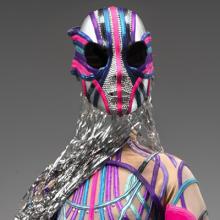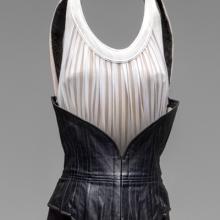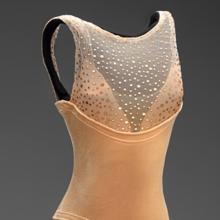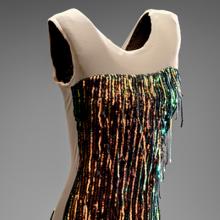International Terminal






Maria Kochetkova performs with a group of dancers in Björk Ballet 2019
Choreographer: Arthur Pita
Costume designer: Marco Morante
Photograph © Erik Tomasson
Courtesy of San Francisco Ballet
R2022.1601.045
Björk Ballet
South-African-born Portuguese choreographer Arthur Pita’s (b. 1972) Björk Ballet celebrates the theatricality of Icelandic singer-songwriter Björk. Pita’s ballet is set to songs spanning Björk’s discography, from 1993’s Debut to 2017’s Utopia. In pondering a theme for San Francisco Ballet’s Unbound: A Festival of New Works (2018), Pita immediately thought of Björk: “The music is so theatrical—it’s big, but in a modern way,” explains Pita. “She’s this very playful, naughty fairy, dancing nymph, otherworldly creature, full of light and love,” he says. “And then you’ve got this very deep, mournful, sorrowful, almost tragedy in some of her songs.” Pita knew the music would drive the dancers and make them feel unbound, true to the festival’s theme. Throughout Björk Ballet, Pita’s choreography for its twenty-two dancers mixes kicks, lunges, and squats with classically inspired technique. In trying to capture Björk’s essence, Pita goes to extremes with his movement. There are cantilevered duets with an underwater quality and a classically based octet, set to “Frosti,” that Pita says, “should look like a ballerina music box on acid.” “Hyperballad,” Pita’s ballet rave, entails a long jumping sequence set to a pumping, driving rhythm. “It’s a metaphor—jumping for joy, jumping for love,” says Pita. Pita collaborated with Latino costume and fashion designer Marco Morante to create Björk Ballet’s stunning costumes. Morante’s costuming includes metallic, fringed body suits with geometric piping.
View In the Studio: Arthur Pita to learn more about the making of Björk Ballet

[costume image]
Björk Ballet unitard, fringe bolero, and mask with fringe 2018
Choreographer: Arthur Pita
Costume designer: Marco Morante
L2022.1601.005a-c
Ellen Rose Hummel, Kimberly Marie Oliver, and Lorena Feijoo perform in Lambarena 2015
Choreographer: Val Caniparoli
Costume designer: Sandra Woodall
Photograph © Erik Tomasson
Courtesy of San Francisco Ballet
R2022.1601.035
Lambarena
San Francisco Ballet has performed choreographer Val Caniparoli’s (b. 1951) Lambarena on an ongoing basis since its premiere in 1995 and many companies have staged the production worldwide. Lambarena takes its name from the town Lambaréné in Gabon where German physician Albert Schweitzer (1875–1965) founded a hospital in 1913. A musical score by the same name is based on Schweitzer’s practice of playing the music of Johann Sebastian Bach (1685–1750) and other European composers on a pedal piano amidst the Central African setting. French composers Pierre Akendengue and Hughes de Courson skillfully interwove African rhythms with extended passages from various Bach compositions. This captivating musical fusion provided inspiration for Caniparoli’s choreography. He combined classical ballet movements with layers of African dance movement, creating a seamless integration of the two styles. To ensure the authenticity of the African components, he enlisted the help of West African dance specialists Zakariya Sao Diouf and Naomi Gedo Johnson-Washington who worked in close collaboration with Caniparoli and San Francisco Ballet dancers.
Oakland-born costume and set designer Sandra Woodall applied the same cultural fusion in her vibrant designs for the ballet. The costumes, though cut and tailored in a Western style, possess an African influence in their colors and patterns. For the women’s dresses, Woodall chose a silk satin material that she hand-painted, then turned the satin inward so the dancers would feel the movement of the fabric on their legs.

[costume image]
Lambarena multicolored dress 1995
Choreographer: Val Caniparoli
Costume designer: Sandra Woodall
Courtesy of San Francisco Ballet
L2022.1601.001
Vanessa Zahorian performs in Haffner Symphony 2010
Choreographer: Helgi Tomasson
Costume designer: Santo Loquasto
Photograph © Erik Tomasson
Courtesy of San Francisco Ballet
R2022.1601.081
Haffner Symphony
Helgi Tomasson (b. 1942), one of the most venerated classical dancers of his generation, celebrated his thirty-seventh and final season as artistic director and principal choreographer with San Francisco Ballet in 2022. Born in Iceland, Tomasson has choreographed more than fifty works for the Company, including full-length productions of Swan Lake, The Sleeping Beauty, Romeo & Juliet, Giselle, and Nutcracker. In 2021, Tomasson received the San Francisco Arts Medallion, created by the Museum of Performance + Design to recognize those individuals whose leadership, action, and generosity have benefited the cultural life of the San Francisco Bay Area.
Tomasson choreographed Haffner Symphony in 1991 for the Mozart & His Time Bicentennial Celebration in San Francisco, featuring Mozart’s “Symphony No. 35 in D Major,” also called the Haffner Symphony. The energy of Mozart’s vibrant music synthesizes with Tomasson’s choreography. In translating Mozart’s music into movement, Tomasson created a dance with vigor and complexity. As the music contains no adagio movement, which is typically where a grand pas de deux (a duet that also includes solos for both dancers) occurs in classical ballet, Tomasson skipped the duet and used the second and third musical movements for back-to-back quartets—one for a woman and three men, and one for a man and three women.
Haffner Symphony features costumes by Academy Award-nominated and Tony Award-winning designer Santo Loquasto (b. 1944). Loquasto has worked on approximately one hundred Broadway productions, either as scenic designer, costume designer, or in both roles.

[costume image]
Haffner Symphony rust-colored tutu with jeweled tiara 1991
Choreographer: Helgi Tomasson
Costume designer: Santo Loquasto
Courtesy of San Francisco Ballet
L2022.1601.018a,b
Dores André and Vitor Luiz perform in Guernica 2018
Choreographer: Annabelle Lopez Ochoa
Costume designer: Mark Zappone
Photograph © Erik Tomasson
Courtesy of San Francisco Ballet
R2022.1601.041
For her first San Francisco Ballet commission, Guernica, Colombian-Belgian Annabelle Lopez Ochoa (b. 1973) was selected as one of twelve choreographers to create a thirty-minute ballet for San Francisco Ballet’s Unbound: A Festival of New Works (2018). Lopez Ochoa drew inspiration from painter Pablo Picasso (1881–1973), particularly Guernica (1937), which he painted in response to the devastating bombing of the Basque town Guernica during the Spanish Civil War. Lopez Ochoa also took inspiration from two of Picasso’s romantic partners: Marie-Thérèse Walter (1909–77), whom he painted in Marie-Thérèse, Face and Profile (1931) and photographer Dora Maar (1907–97), who documented the creation of Picasso’s Guernica. Lopez Ochoa’s ballet also encompasses flamenco dance and bullfighting. The four principal dancers wear bull horns; the bull symbolizes violence and power—aggressor and victim.
Cubism captivates Lopez Ochoa because of how the brain tries to make sense of shapes that can be interpreted in multiple ways. “How do you put cubism into movement?” This is the question Lopez Ochoa sought to answer in her choreography. She creates cubist effects by arranging dancers into poses, so that the brain appears to see four heads and only two legs. The four principal dancers appear on stage as four embodiments of a person, sometimes separate, sometimes in pairs, or as a foursome.
View the short film of Anabelle Lopez Ochoa’s Guernica

[costume image]
Guernica black-and-white halter leotard with leather corset and horned headpiece 2018
Choreographer: Annabelle Lopez Ochoa
Costume designer: Mark Zappone
Courtesy of San Francisco Ballet
L2022.1601.003a,b
Yuan Yuan Tan and Vito Mazzeo perform in Symphonic Dances 2012
Choreographer: Edwaard Liang
Costume designer: Mark Zappone
Photograph © Erik Tomasson
Courtesy of San Francisco Ballet
R2022.1601.051
Born in Taipei, Taiwan, Edwaard Liang (b. 1975) grew up in the Bay Area. Symphonic Dances, which premiered in 2012, was Liang’s first major work for San Francisco Ballet. For the commission, Liang chose to create a “spiritual, abstract world,” he says, “what you would call the in-between, where it’s neither this world nor the next world. As a choreographer, I don’t want to limit audiences in what they see…I really want them to find themselves through it.” The concept coincides with his choice of music—Russian composer Sergei Rachmaninov’s (1873–1943) Symphonic Dances (1940)—the composer’s final major composition, which he wrote while living in the United States. “Some people would call it dark, but I consider it spiritual,” says Liang, who was drawn to the composition’s intensity and the fantasy world Rachmaninov created through the music. This is what Liang sought to emulate in his choreography.
Symphonic Dances features costumes designed by Mark Zappone. An established costume designer, he has worked with Liang on original works commissioned for San Francisco Ballet as well as works at BalletMet, where Liang serves as artistic director. The costumes feature the principal dancers in bright gold and burnt orange. The women wear flowing dance dresses with patterned diaphanous skirts. In 2018, Liang choreographed The Infinite Ocean for San Francisco Ballet as part of Unbound: A Festival of New Works (2018), where he again partnered with Zappone for the costume designs.
View In the Studio: Edwaard Liang to learn more about the making of Symphonic Dances

[costume image]
Symphonic Dances golden yellow dress with attached leotard 2012
Choreographer: Edwaard Liang
Costume designer: Mark Zappone
Courtesy of San Francisco Ballet
L2022.1601.007
Frances Chung and Angelo Greco perform in The Promised Land 2022
Choreographer: Dwight Rhoden
Costume designer: Christine Darch
Photograph © Erik Tomasson
Courtesy of San Francisco Ballet
R2022.1601.060
The Promised Land
Ohio native Dwight Rhoden’s (b. 1962) third work for San Francisco Ballet, The Promised Land, premiered as part of the 2022 Celebration, the Company’s first in-person season since closing partway through the 2020 Repertory Season due to the COVID-19 pandemic. Rhoden has a distinctive choreographic style. Previous artistic director Helgi Tomasson explained that the “dancers love working with Dwight because he draws from their athleticism and strong technique to showcase the best in each of them.” The feeling is mutual. Rhoden explained, “It’s no secret that I really love these dancers in this company. You have to know, as a choreographer, when to get out of the way and allow the dancers to—become. Because the work doesn’t live without them. So, I depend on them to bring it to life.” Over the course of a combination of virtual and in-person rehearsals during the summer of 2021, Rhoden shared some of his intentions with the dancers, and then focused on letting ideas emerge as the dancers mastered the intricate choreography.
Within Rhoden’s piece there is a range of textures, going from fast and chaotic to pensive and serene, paralleling the uncertainty of contemporary world events. While The Promised Land does not have a fixed story, there is a “wandering narrative” throughout inspired by circumstances of the past few years: the COVID-19 pandemic and the struggle for racial equality. But as Rhoden points out, his ballet is more about looking back and moving forward, or “how we recover.”
View About Rhoden’s The Promised Land to learn more about the making of the ballet

[costume image]
The Promised Land fringe dress with attached leotard 2022
Choreographer: Dwight Rhoden
Costume designer: Christine Darch
Courtesy of San Francisco Ballet
L2022.1601.010





